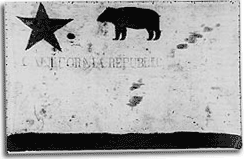Americans were for a long time an active presence in California, beginning with men engaged in the sea otter trade in the early 19th century. As that activity declined, other Americans developed ranching operations in the Sacramento River valley, in response to the immense Eastern demand for tallow and hides.
 Unlike Americans living in Monterey or Los Angeles, who had intermarried and become friends with the old California families, those in the Sacramento Valley had kept separate. They worried about what might happen to them if they fell completely under Mexican rule, and felt the treatment of certain fur traders in the past, and more recently the expulsion of Fremont supported their concern.
Concern worsened when the (false) news that 250 Mexican-Californians were marching on Sacramento. A number of Americans went to Marysville Buttes, where Fremont had encamped on his return from Oregon. Early in June, Ezekial Merritt and a dozen other Americans seized a large number of government horses that were being driven to San Jose.
On June 14, 1846, Americans seized the administrative capital at Sonoma before word arrived about the outbreak of hostilities between Mexico and the United States. The short-lived Bear Flag Republic was born. A hastily stitched flag, whose star and a grizzly bear's likeness some thought looked more porcine than ursine, was raised on the public square in Sonoma. The Republic of California, better known as the Bear Flag Republic, was estalished under the leadership of William B. Ide. A proclamation set forth the justification and purpose of the revolution, but before the government could get properly underway, the short-lived Bear Flag Republic was eclipsed by the arrival of the U.S. Navy under the command of John D. Sloat on July 10.
Pivotal in these events was John C. Frémont. He was assigned to the Army Corps of Topographical Engineers, which was charting new trails in the West. Frémont and his cohorts were ordered out of California by Mexican authorities; he established a camp in the Oregon Territory. In June 1846, he returned and reached the Sonoma area, where he played an unofficial, but significant role in the Bear Flag revolt. Frémont later served as the military commander of the pro-American community. Whether his actions were motivated by secret orders from Washington or by pure ambition remains unclear.
The Bear Flag Republic was quickly eclipsed by the arrival of the U.S. Navy under the command of John D. Sloat in July.
Unlike Americans living in Monterey or Los Angeles, who had intermarried and become friends with the old California families, those in the Sacramento Valley had kept separate. They worried about what might happen to them if they fell completely under Mexican rule, and felt the treatment of certain fur traders in the past, and more recently the expulsion of Fremont supported their concern.
Concern worsened when the (false) news that 250 Mexican-Californians were marching on Sacramento. A number of Americans went to Marysville Buttes, where Fremont had encamped on his return from Oregon. Early in June, Ezekial Merritt and a dozen other Americans seized a large number of government horses that were being driven to San Jose.
On June 14, 1846, Americans seized the administrative capital at Sonoma before word arrived about the outbreak of hostilities between Mexico and the United States. The short-lived Bear Flag Republic was born. A hastily stitched flag, whose star and a grizzly bear's likeness some thought looked more porcine than ursine, was raised on the public square in Sonoma. The Republic of California, better known as the Bear Flag Republic, was estalished under the leadership of William B. Ide. A proclamation set forth the justification and purpose of the revolution, but before the government could get properly underway, the short-lived Bear Flag Republic was eclipsed by the arrival of the U.S. Navy under the command of John D. Sloat on July 10.
Pivotal in these events was John C. Frémont. He was assigned to the Army Corps of Topographical Engineers, which was charting new trails in the West. Frémont and his cohorts were ordered out of California by Mexican authorities; he established a camp in the Oregon Territory. In June 1846, he returned and reached the Sonoma area, where he played an unofficial, but significant role in the Bear Flag revolt. Frémont later served as the military commander of the pro-American community. Whether his actions were motivated by secret orders from Washington or by pure ambition remains unclear.
The Bear Flag Republic was quickly eclipsed by the arrival of the U.S. Navy under the command of John D. Sloat in July.